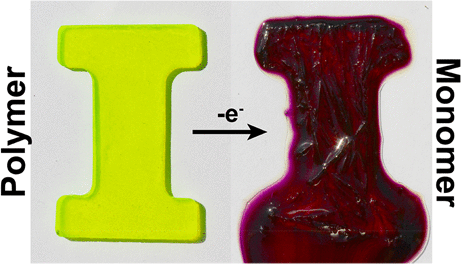当前位置:
X-MOL 学术
›
ACS Cent. Sci.
›
论文详情
Our official English website, www.x-mol.net, welcomes your feedback! (Note: you will need to create a separate account there.)
Triggered Transience of Plastic Materials by a Single Electron Transfer Mechanism.
ACS Central Science ( IF 18.2 ) Pub Date : 2020-02-05 , DOI: 10.1021/acscentsci.9b01237 Adam M Feinberg 1 , Oleg Davydovich 1 , Evan M Lloyd 1 , Douglas G Ivanoff 1 , Bethany Shiang 1 , Nancy R Sottos 1 , Jeffrey S Moore 1
ACS Central Science ( IF 18.2 ) Pub Date : 2020-02-05 , DOI: 10.1021/acscentsci.9b01237 Adam M Feinberg 1 , Oleg Davydovich 1 , Evan M Lloyd 1 , Douglas G Ivanoff 1 , Bethany Shiang 1 , Nancy R Sottos 1 , Jeffrey S Moore 1
Affiliation

|
Transient polymers rapidly and controllably depolymerize in response to a specific trigger, typically by a chain-end unzipping mechanism. Triggers, such as heat, light, and chemical stimuli, are generally dependent on the chemistry of the polymer backbone or end groups. Single electron transfer (SET), in contrast to other triggering mechanisms, is achievable by various means including chemical, electrochemical, and photochemical oxidation or reduction. Here, we identify SET and subsequent mesolytic cleavage as the major thermal triggering mechanism of cyclic poly(phthalaldehyde) (cPPA) depolymerization. Multimodal SET triggering is demonstrated by both chemical and photoredox-triggered depolymerization of cPPA. Redox-active small molecules (p-chloranil and 1,3,5-trimethoxybenzene) were used to tune the depolymerization onset temperature of cPPA over the range 105-135 °C. Extending this mechanism to photoredox catalysis, N-methylacridinium hexafluorophosphate (NMAPF6) was used to photochemically degrade cPPA in solution and thin films. Finally, we fabricated photodegradable cPPA monoliths with a storage modulus of 1.8 GPa and demonstrated complete depolymerization within 25 min of sunlight exposure. Sunlight-triggered depolymerization of cPPA is demonstrated and potentially useful for the manufacture of transient devices that vanish leaving little or no trace. Most importantly, this new mechanism is likely to inspire other SET-triggered transient polymers, whose development may address the ongoing crisis of plastic pollution.
中文翻译:

通过单电子转移机制触发塑料的瞬变。
瞬态聚合物响应特定的触发因素,通常通过链端解链机制快速可控地解聚。触发因素,例如热,光和化学刺激,通常取决于聚合物主链或端基的化学性质。与其他触发机制相比,单电子转移(SET)可通过各种方式实现,包括化学,电化学和光化学氧化或还原。在这里,我们确定SET和随后的介观裂解是环状聚苯二甲醛(cPPA)解聚的主要热触发机制。cPPA的化学和光氧化还原触发的解聚都证明了多峰SET触发。氧化还原活性小分子(对氯苯醌和1,3,使用5-三甲氧基苯)在105-135°C范围内调节cPPA的解聚起始温度。为了将此机理扩展到光氧化还原催化作用,使用了N-甲基ac六氟磷酸盐(NMAPF6)对溶液和薄膜中的cPPA进行光化学降解。最后,我们制造了储能模量为1.8 GPa的可光降解cPPA整料,并证明在阳光照射25分钟内完全解聚。证明了cPPA在阳光下引发的解聚反应,对于制造消失几乎没有或几乎没有痕迹的瞬态器件可能很有用。最重要的是,这种新机制可能会激发其他SET触发的瞬态聚合物,其发展可能解决持续的塑料污染危机。N-甲基ac基六氟磷酸酯(NMAPF6)用于光化学降解溶液和薄膜中的cPPA。最后,我们制造了储能模量为1.8 GPa的可光降解cPPA整料,并证明在阳光照射25分钟内完全解聚。证明了cPPA在阳光下引发的解聚反应,对于制造消失几乎没有或几乎没有痕迹的瞬态器件可能很有用。最重要的是,这种新机制可能会激发其他SET触发的瞬态聚合物,其发展可能解决持续的塑料污染危机。N-甲基ac基六氟磷酸酯(NMAPF6)用于光化学降解溶液和薄膜中的cPPA。最后,我们制造了储能模量为1.8 GPa的可光降解cPPA整体材料,并证明在阳光照射25分钟内完全解聚。证明了cPPA在阳光下引发的解聚反应,对于制造消失几乎没有或几乎没有痕迹的瞬态器件可能很有用。最重要的是,这种新机制可能会激发其他SET触发的瞬态聚合物,其发展可能解决持续的塑料污染危机。8 GPa,并证明在暴露于阳光下25分钟内完全解聚。证明了cPPA在阳光下引发的解聚反应,对于制造消失几乎没有或几乎没有痕迹的瞬态器件很有用。最重要的是,这种新机制可能会激发其他SET触发的瞬态聚合物,其发展可能解决持续的塑料污染危机。8 GPa,并证明在暴露于阳光下25分钟内完全解聚。证明了cPPA在阳光下引发的解聚反应,对于制造消失几乎没有或几乎没有痕迹的瞬态器件可能很有用。最重要的是,这种新机制可能会激发其他SET触发的瞬态聚合物,其发展可能解决持续的塑料污染危机。
更新日期:2020-02-26
中文翻译:

通过单电子转移机制触发塑料的瞬变。
瞬态聚合物响应特定的触发因素,通常通过链端解链机制快速可控地解聚。触发因素,例如热,光和化学刺激,通常取决于聚合物主链或端基的化学性质。与其他触发机制相比,单电子转移(SET)可通过各种方式实现,包括化学,电化学和光化学氧化或还原。在这里,我们确定SET和随后的介观裂解是环状聚苯二甲醛(cPPA)解聚的主要热触发机制。cPPA的化学和光氧化还原触发的解聚都证明了多峰SET触发。氧化还原活性小分子(对氯苯醌和1,3,使用5-三甲氧基苯)在105-135°C范围内调节cPPA的解聚起始温度。为了将此机理扩展到光氧化还原催化作用,使用了N-甲基ac六氟磷酸盐(NMAPF6)对溶液和薄膜中的cPPA进行光化学降解。最后,我们制造了储能模量为1.8 GPa的可光降解cPPA整料,并证明在阳光照射25分钟内完全解聚。证明了cPPA在阳光下引发的解聚反应,对于制造消失几乎没有或几乎没有痕迹的瞬态器件可能很有用。最重要的是,这种新机制可能会激发其他SET触发的瞬态聚合物,其发展可能解决持续的塑料污染危机。N-甲基ac基六氟磷酸酯(NMAPF6)用于光化学降解溶液和薄膜中的cPPA。最后,我们制造了储能模量为1.8 GPa的可光降解cPPA整料,并证明在阳光照射25分钟内完全解聚。证明了cPPA在阳光下引发的解聚反应,对于制造消失几乎没有或几乎没有痕迹的瞬态器件可能很有用。最重要的是,这种新机制可能会激发其他SET触发的瞬态聚合物,其发展可能解决持续的塑料污染危机。N-甲基ac基六氟磷酸酯(NMAPF6)用于光化学降解溶液和薄膜中的cPPA。最后,我们制造了储能模量为1.8 GPa的可光降解cPPA整体材料,并证明在阳光照射25分钟内完全解聚。证明了cPPA在阳光下引发的解聚反应,对于制造消失几乎没有或几乎没有痕迹的瞬态器件可能很有用。最重要的是,这种新机制可能会激发其他SET触发的瞬态聚合物,其发展可能解决持续的塑料污染危机。8 GPa,并证明在暴露于阳光下25分钟内完全解聚。证明了cPPA在阳光下引发的解聚反应,对于制造消失几乎没有或几乎没有痕迹的瞬态器件很有用。最重要的是,这种新机制可能会激发其他SET触发的瞬态聚合物,其发展可能解决持续的塑料污染危机。8 GPa,并证明在暴露于阳光下25分钟内完全解聚。证明了cPPA在阳光下引发的解聚反应,对于制造消失几乎没有或几乎没有痕迹的瞬态器件可能很有用。最重要的是,这种新机制可能会激发其他SET触发的瞬态聚合物,其发展可能解决持续的塑料污染危机。


























 京公网安备 11010802027423号
京公网安备 11010802027423号